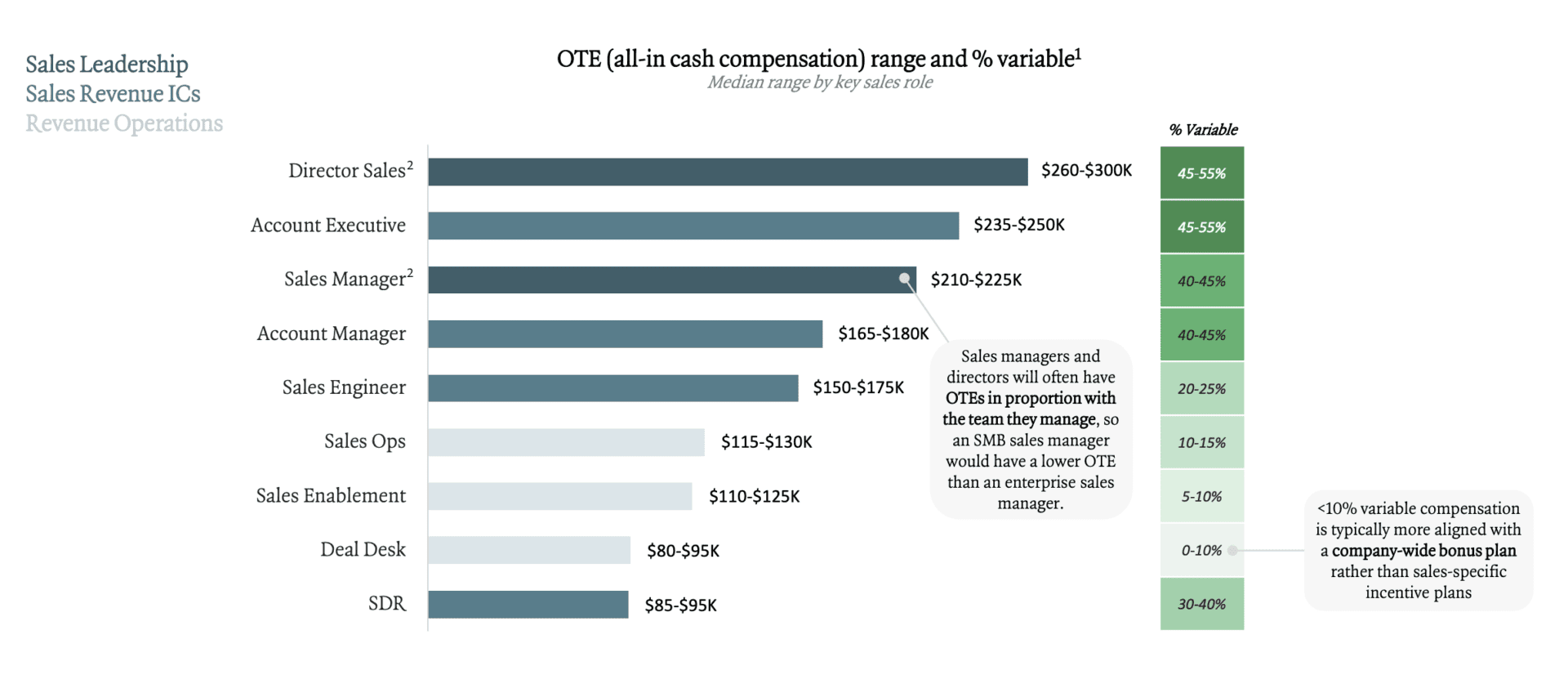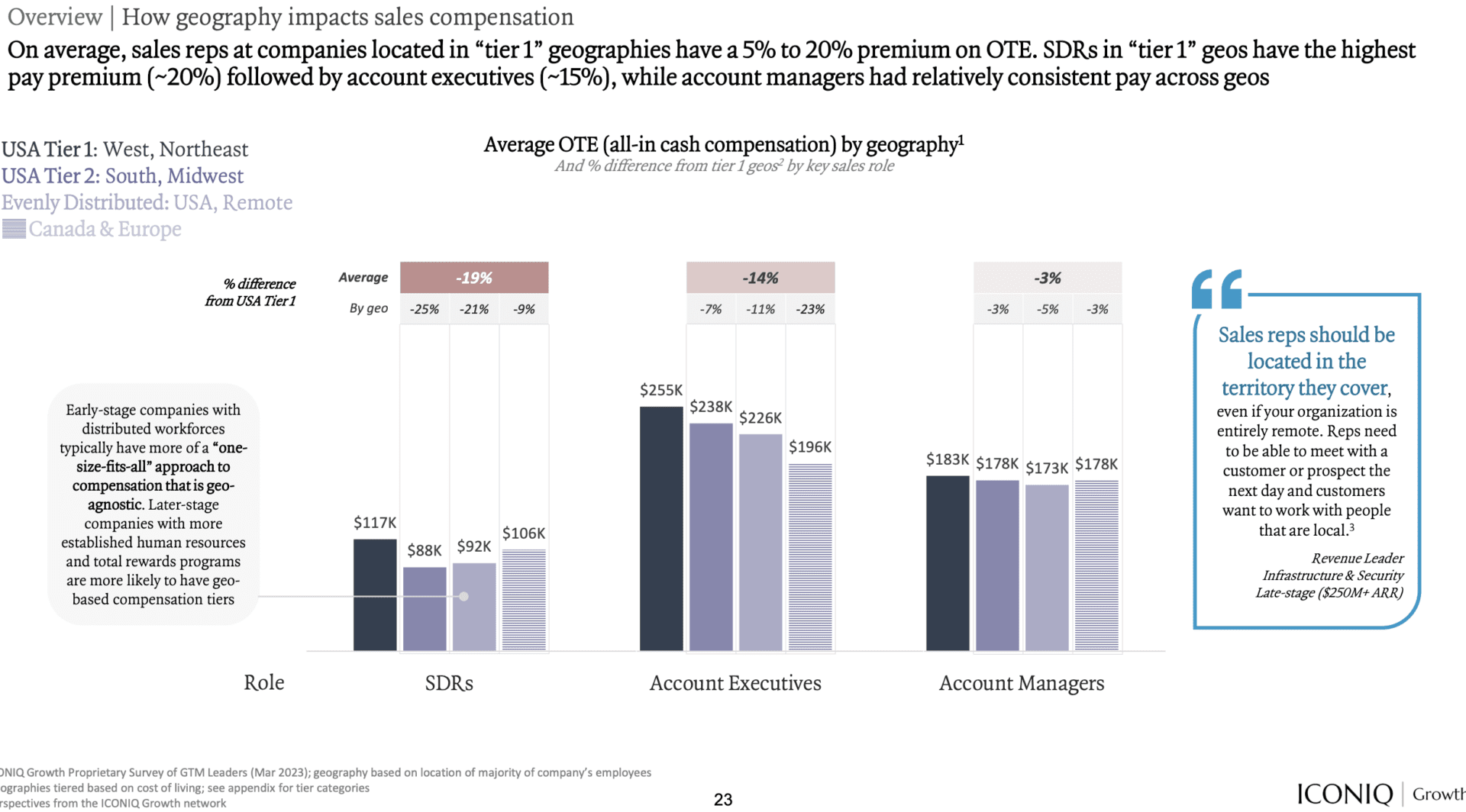So leading growth stage VC Iconiq has published its latest and very detailed Definitive Guide to Sales Compensation here. It’s very detailed and oriented more toward growth-stage scale-ups — but it’s excellent. Everyone should have a read.
I didn’t so much learn from it as confirm — confirm things I’ve seen, known, and put into practice, and seen it confirmed across many SaaS startups.
My top take-aways:
#1. Yes, 50/50 Base/Variable for AEs remains the standard, and 4x-5x+ Quota:OTE ratio remains the standard. Corners were cut in the boom times of 2021, but we are back to sane sales models. Enterprise Quota:OTE ratios are higher (5x+), SMB is a bit lower, but at the end of the day, you need to close 4x-5x what you take home.
#2. Renewals, if they are done by sales, are paid out at about 40% of an initial commission. A complex topic here of when it makes sense to have sales involved in renewals, but helpful to see they get about 40% of the commission of a new deal.
#3. Sales Leadership Typically Has 40% or So From Variable Comp. CSMs Are Pushing Up to 20%. That sounds about right. I prefer a 50/50/25 model for a VP of Sales, at least in the early-ish days. But more have pushed for higher and higher bases over the past years.
#4. Later stage AEs have OTEs for $235k-$250k — but they have to close a lot to actually earn it ($1m+). SDRs $85k-$95k. The chart below on comp ranges is helpful. Note again this skews toward late-stage startups and scale-ups. Generally, I’d say earlier stage comp is 10%-20% lower.
#5. SaaS Companies Are Still Paying 5%-20% Higher OTEs in “Tier 1” Cities like SF, NYC, etc. Makes sense to me. And folks with remote teams pay less. Most SaaS companies have not really gone flat at scale, although many now do at the earlier stages. Comp is also about 20% lower in Europe and Canada, which is consistent with my experience.
#6. Enterprise SDRs Typically Have to Book 5 SQLs Per Month, Mid-Market SDRs About 20. 20 has always been my rule. Good to see it confirmed here with the latest data:
#7. 33% of SaaS Startups Now Comp SDRs Based on Pipeline They Source vs. SQL. I’ve tried this as well; it has Pros and Cons. The Pro is it tends to align to bigger and better deals. The Con is SDRs work on fewer, bigger deals. When they do this, they have to source, on average, about 10x-15x their OTE in pipeline.
#8. 82% of SaaS Startups Use Sales Accelerators, Mainly Based on Exceeding Base Quota. Probably not a surprise. Reward your very best. The typical 10% base commission rate accelerates up to 20% for the highest performers, once quota is hit.
#9. AEs Are Typically Given a 4-6 Month Ramp, SDRs a 2-3 Month Ramp. The best can do it in half this time, but helpful to see best practices here.
#10. Ramped Sales Teams See 60%-70% Quota Attainment, Up to 80% for the Very Best Teams. Having Said That — Q1’23 Was Rough. Many SaaS companies are struggling to hit those metrics these days, but that’s still consistent with my experience in how the best sales teams achieve when startups are fast growing. Having said that, many struggling SaaS startups are seeing attainment rates at half that today.
And a few other small notes I found helpful:
- 53% of SaaS companies use clawbacks. I know reps hate them, but I find they really help curtail churn-and-burn deals.
- Only 14% of SaaS companies cap commissions. Let the best run!
- 50% of PLG companies pay sales a commission on self-serve deals that convert to paid without a human touch, at least in the early days. It’s a complex issue, but in the end, it’s often simpler to pay reps on all the deals they cover and own.
A great report!












